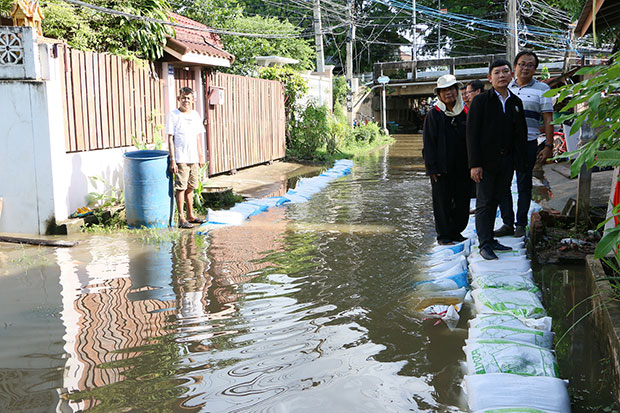
A big flood threatens Phichit's economic zones and inundated areas in other provinces are likely to expand with the weather bureau forecasting more rain across the country for at least the next three days.
Authorities in Phichit are keeping a close watch with floodwater threatening to burst into economic zones and crowded communities in three districts - Muang, Taphan Hin and Bang Mun Nak.
The most critical area is Bang Mun Nak municipality where flooding currently "surrounds the economic areas", officials said on Monday.
Deputy Bang Mun Nak mayor Annop Tankittithawon said more than 20,000 sand bags have been used to build flood walls in areas where the water, both overflow from the Nan River and mountain torrents from adjacent Phetchabun province, is expected to run through.
Riverside communities in Bang Mun Nak market were already flooded, officials said.
With more rain threatening this week, it is unlikely Muang, Taphan Hin and Bang Mun Nak districts will escape severe inundation. The surrounding areas, mostly farmland, are already large ponds.
Overflow from the Yom River has also begun to flood parts of Sam Ngam, Pho Prathap Chang, Bung Na Rang and Pho Thale districts, adding to worries in the northern province.
Tak, located in the far northwest, is also bearing the brunt. About 3,000 people in Ban Tak and Sam Ngao districts are struggling against flooding. On Monday 200 more in Umphang district became cut off as the powerfully flowing current destroyed a century-old wooden bridge on the main access road, officials said. (continued below)

This century-old bridge has been destroyed by the flood in Umphang district, Tak. (Photo by Assawin Pinitwong)
Authorities in Sukhothai, to the north of Phichit, were also busy protecting Sukhothai Hospital and state agencies against flooding. Two major reservoirs - Huai Tha Phae and Mae Mok - are brimming over and their gates have been opened to release water.
Runoff from these northern provinces is also flowing into the Chao Phraya River, prompting irrigation officials in Chai Nat to increase the rate of water being released from the Chao Phraya barrage dam to 2,000 cubic metres a second. This means riverside comunities in Sing Buri, Ang Thong and Ayutthaya, which are downstream, can expect more flooding.
Farmers in four districts of Ang Thong - Muang, Wiset Chai Chan, Pa Mok and Chaiyo - have already seen 9,237 rai of their land submerged.
A fresh worry arose as runoff surged downriver through Ayutthaya on Sunday, threatening to swamp ancient temples and historical sites beside the Chao Phraya River.
Monks at Wat Kasattrathirat Worawihan in Phra Nakhon Si Ayutthaya district rushed to reinforce its flood wall of sandbags. Its height of one metre was not enough, the monks said, as they laboured to increase it by another 50cm. (continues below)

Monks rush to build up the sandbag dyke at Wat Kasattrathirat Worawihan in Ayutthaya province. (Photo by Suthorn Pongpao)
At Wat Chaiwatthanaram, another riverside temple located in the district's Historical Park, only its 200-metre long embankment wall was keeping the river out. The water level was one metre higher than the temple compound, officials said.
The low-lying province is just 85km north of Bangkok, which is next in the path of the flood surge down the Chao Phraya River. The capital, like most regions, is expected to get more rain this week.
The Meteorological Department said on Monday heavy rainfall is expected throughout Thailand at least until Wednesday as a result of the prevailing monsoon and a low pressure trough forecast to move from the South China Sea over Viet Nam and into Thailand during the three days.